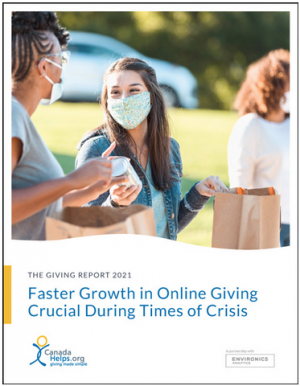 By Susan D. Phillips.
By Susan D. Phillips.
While the effects of the COVID pandemic may be diminishing, several emergent forces will likely preclude sliding into a comfortable new normal in 2023. In particular, five trends, already apparent in 2022, stand out that will require adaptation and innovation across the sector. These focus on operational matters for organizations, and recognizing that the sector as a whole still needs to address the overarching issues of climate change and Indigenous and racial justice.
1. The long-term decline in giving and volunteering will be amplified

Fewer Canadians are giving to charities: this consistent decline over the past decade has resulted in a concentration of giving among a shrinking, older population.
Fewer Canadians are giving to charities: this has been a consistent decline over the past decade that has resulted in a concentration of giving among a shrinking older population. In recent years, the decrease in participation rates and amounts donated has been most acute among families earning $150,000 or more (CanadaHelps, 2022). Inflation, mortgage costs and household debt can be expected to take a bite out of charitable giving across the general population in 2023. This will put pressure on fundraising for a wide range of charities, which, when coupled with impending government austerity and rising costs due to inflation, will likely necessitate cutbacks or revamping of programs and services.
Formal volunteering (through organizations) has experienced a similar long-term decrease and concentration among the Baby Boomer generation. While GenZs (born 1996–2012) and Millennials (1981–1995) volunteer in substantial numbers and in different forms, their number of hours is about half that of the Boomers, leaving a substantial gap in volunteering. In the last quarter of 2022, 66% of nonprofits indicated they were facing a shortage of volunteers and half experienced challenges of retention, resulting in a reduction or cancellation of services.
So far, the decline in giving and volunteering hasn’t been on the radar of Canadian governments, even though it has significant public policy implications. For example, in times of disaster, governments count on the public stepping up with donations; this is likely to drop quite dramatically or become even more unpredictable in coming years. Given that contracts with charities for “public” services rarely cover the real costs of these services, governments rely on philanthropy to subsidize the delivery of these services. These invisible subsidies can be expected to shrink in 2023. Given the multitude of research that shows that volunteering has positive benefits for social cohesion, generalized trust and societal wellbeing, reduced volunteerism is not only a loss for charities and nonprofits and those they serve but for Canadian society as a whole.
2. An increase in big gifts

A $500 million bequest to the Winnipeg Foundation by Miriam Bergen, including the shares of her real estate company, is the largest gift from an individual to a charity in Canadian history.
In spite of the general decline in giving, demographics and growth in the number of ultra-affluent households may lead to a rise in very large gifts, as Keith Sjögren observes in an article on the economic and financial drivers of philanthropy in 2023. The signs are already evident in the historically large gifts made in recent years, including: $105 million from the Peter Gilgan Foundation to rebuild a hospital facility in Mississauga, the largest gift ever made to a Canadian hospital; $250 million to the University of Toronto’s Faculty of Medicine by the foundation of James and Louise Temerty; and a $500 million bequest by Miriam Bergen, including the shares of her real estate company, to the Winnipeg Foundation.

“Donor-Advised Funds: 2023 Outlook,” an article by Keith Sjögren, looks at what’s influencing the increase in Donor-Advised Funds (DAFs) in Canada, as well as how charities benefit from DAFs and why DAFs will likely attract increased scrutiny from regulators.
As retiring professionals sell their practices, and as older entrepreneurs sell their family businesses – and as wealth passes from one generation to the next, some of the sudden increase in wealth is likely to be donated. During these “liquidity events,” Donor Advised Funds (DAFs), which provide immediate benefit of tax credits and delayed decisions on disbursements, are likely to become even more popular (see the DAFs article by Keith Sjögren).
Other than windfalls for a few select charities, this results in the growing importance of wealth advisors and family offices. If advisors are going to serve their clients well by having conversations and providing guidance about philanthropy, they’ll need to be well informed about the sector. (For example, download “A Guide for Professional Financial Advisors,” from Philanthropic Foundations of Canada.) The competency framework and MFA-P designation offered by the Canadian Association of Gift Planners (CAGP) is also a good place to start.
Philanthropy is in for a shake-up as we see more mega-gifts directed toward systems change and radical innovation. Some of these are already in motion, including the $100 million gift by the Wilson5 Foundation (created by Lululemon founder Chip Wilson and family) to protect pristine wilderness in BC and the commitment of the Ivey Foundation to spend down its $100 million endowment in five years for action on climate change. In early 2023, the federal government will select which organization will implement its $200 million Black-led endowment fund, which should create new leadership not only for Black communities but for justice-oriented philanthropy overall.
3. Philanthropy and the sector will be under greater scrutiny, with higher expectations

Charities can expect increased scrutiny in 2023, particularly related to their governance following the scandals surrounding WE Charity and Hockey Canada.
The critiques that have been levied at philanthropy in the U.S. – that it’s founded on injustice and inequality and is elitist and elite-serving – have moved (albeit less vigorously) into Canada, producing greater scrutiny of institutional philanthropy. The federal government’s 2022 consultation on what percentage of registered charities’ assets (then at 3.5%) must be disbursed annually opened up vigorous discussions about the work of foundations, the value of perpetual endowments, and the need for better data. While the question of the mandatory Disbursement Quota (DQ) has been resolved by an increase to 5% (for organizations with investment assets over $1 million), the debate surrounding the DQ decision has led to wider questions about the work of foundations. On the positive side, this may prompt greater use of impact investing to put assets to work, and may lead to more transparency and strategic efforts to make philanthropy more impactful. Charities, too, can expect increased scrutiny, particularly related to their governance following the scandals surrounding WE Charity and Hockey Canada.
4. Leadership transition and labour-market shortages

While the worker shortage is most acute in caring professions, the nonprofit sector in general can be expected to struggle to retain or attract employees unless it can make working conditions, salaries and the advantages of the nonprofit environment more attractive.
In the U.S., COVID-19 is said to have sparked the Great Resignation of workers leaving their jobs. This hasn’t been the case in Canada. Indeed, 2022 was a banner year for the Canadian labour market: the economy gained jobs and unemployment decreased. The exception is in health and social services – jobs that are a significant part of the nonprofit sector, particularly for women, immigrants and Indigenous and racialized people. Despite record high number of job vacancies in health and social services (higher than in any other industry), employment declined in this sub-sector; people are leaving and not entering this field due to burnout, compassion fatigue, working conditions and low pay.
While not experiencing massive resignations, Canada seems to have experienced a Great Rethink during the pandemic: people reconsidered what they want out of work and life. This rethink is being manifested at the top end of leadership in the sector – in Executive Director/CEO positions – which already faced an aging demographic and has led to retirement in substantial numbers (although we don’t have good data).
Replacing leaders won’t be easy as the sector has never invested heavily in training and professional development or in building a successful pipeline, particularly a diverse and inclusive one (For example, download the pdf “Shaping the Future: Leadership in Ontario’s Nonprofit Labour Force,” from the Ontario Nonprofit Network and the Mowat Centre). The good news is that there should be plenty of opportunities for those seeking leadership positions in the sector, although the leadership transition could be bumpy, at best, for many organizations.
5. Engaging digital and configuring core business
 As organizations moved to remote work during the pandemic, we all became more proficient at working online – with all the challenges and creativity that entailed. With the speed of technological change, however, that experience may seem like dipping a toe in cold water when organizations need to take the full, polar-bear plunge. Few of us know how to do that or appreciate the opportunities and pitfalls that ChatGPT and other AI applications will create for nonprofits’ core business operations and the kinds of skills this new digital era will require.
As organizations moved to remote work during the pandemic, we all became more proficient at working online – with all the challenges and creativity that entailed. With the speed of technological change, however, that experience may seem like dipping a toe in cold water when organizations need to take the full, polar-bear plunge. Few of us know how to do that or appreciate the opportunities and pitfalls that ChatGPT and other AI applications will create for nonprofits’ core business operations and the kinds of skills this new digital era will require.
In short, there are new challenges ahead for the sector but also the advantage of young, diverse leaders who can lead change. Their work needs to be supported with better data and analysis, with cultivation of new leadership and governance skills, and critical conversations about the direction of philanthropy. Now in its tenth year, the Master of Philanthropy and Nonprofit Leadership (MPNL) program was created to be a key part of this support system.
Dr. Susan D. Phillips is a Professor in the School of Public Policy and Administration and Graduate Supervisor of the Philanthropy and Nonprofit Leadership program at Carleton University, and an Editor of “PANL Perspectives.” Phillips is on Twitter and LinkedIn. Photo of polar bear is courtesy Hans Jurgen-Mager
Monday, January 30, 2023 in For homepage, News & Events, Trends
Share: Twitter, Facebook



